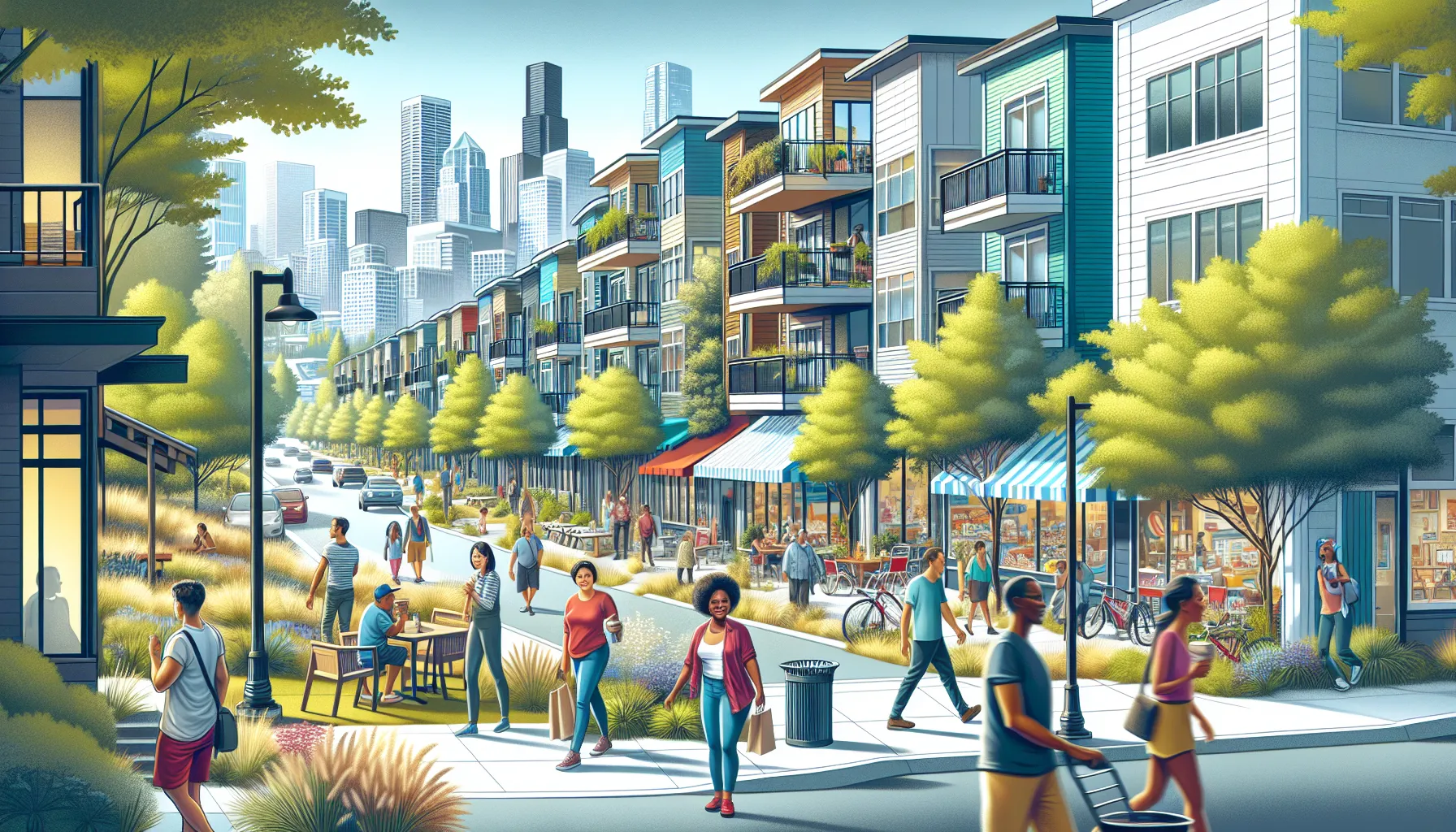Key Takeaways
- Washington State’s cost of living varies widely by location, with urban centers like Seattle experiencing significantly higher housing prices than smaller cities like Spokane.
- The median home price in Seattle is around $800,000, while Spokane’s averages about $450,000, highlighting the importance of understanding regional differences in housing markets.
- Everyday expenses such as groceries, transportation, and healthcare can fluctuate between urban and rural areas, affecting overall budgeting for homebuyers.
- Utility costs in Washington are approximately 10% higher than the national average, and property taxes generally average around 1% of a home’s assessed value, contributing to ongoing homeownership expenses.
- The job market in cities like Seattle offers higher wages but can present challenges for newcomers due to living costs outpacing income levels; careful planning is essential for financial success.
- Understanding the unique dynamics of different neighborhoods can guide homebuyers in choosing locations that align with their lifestyle preferences and financial capabilities.
Washington State offers a stunning blend of natural beauty and vibrant urban life, but navigating its cost of living can be tricky for homebuyers. With diverse cities like Seattle and Spokane, each area presents unique financial challenges and opportunities. Understanding these factors is crucial for making informed decisions about where to plant our roots.
In this guide, we’ll explore the key aspects of Washington’s cost of living, from housing prices to everyday expenses. Whether we’re relocating for work or seeking a fresh start, knowing what to expect helps us budget effectively and find the perfect home. Let’s dive into the essentials that will empower us on our homebuying journey in the Evergreen State.
Overview of Washington State’s Cost of Living
Washington State’s cost of living varies significantly based on geographic location and lifestyle choices. Major cities like Seattle often feature higher housing costs compared to smaller towns such as Spokane or Kennewick. Current data shows that the median home price in Seattle hovers around $800,000, while markets like Spokane average about $450,000. This disparity emphasizes the importance of understanding regional differences when considering relocation.
Everyday expenses also fluctuate across the state. Grocery prices, transportation costs, and healthcare are typically higher in urban centers but can be more affordable in rural areas. For instance, transportation in Seattle can be impacted by a more extensive public transit system, which may reduce reliance on personal vehicles, even though ride shares and parking can add up.
Utilities and property taxes present additional considerations. Washington State’s average utility costs are approximately 10% higher than the national average. Property taxes, while varying by county, generally average around 1% of assessed value, impacting overall homeownership affordability. Prospective buyers should factor in these ongoing expenses when budgeting.
Job markets in Washington also reflect on living costs. Cities with thriving industries, such as tech hubs in Seattle and Bellevue, attract higher wages. However, this can create a challenging environment for newcomers who may face steep costs without matching income levels. Understanding this dynamic can help homebuyers set realistic financial goals.
Navigating the cost of living in Washington State involves careful planning. We encourage readers to evaluate local market trends, seek guidance from real estate professionals, and consider long-term financial implications. This approach helps ensure informed decisions that align with individual or family needs.
Housing Market Trends

Understanding the housing market trends in Washington State is essential for prospective homebuyers. The state’s real estate landscape reflects the diverse economic conditions across cities and regions, shaping homebuying experiences. We explore key trends that influence housing affordability, availability, and buyer preferences.
Average Home Prices
Average home prices fluctuate significantly across Washington State. In urban areas like Seattle and Bellevue, the median home price approaches $800,000, driven by high demand and limited inventory. Conversely, cities such as Spokane present a more affordable entry point with average prices around $450,000. Smaller towns and rural areas often offer even lower prices, making them attractive for first-time buyers seeking value. Recognizing the differences in pricing can help us strategize effectively, identifying suitable locations that align with our budgets and lifestyle preferences.
Rent vs. Buy Analysis
Determining whether renting or buying is more financially viable involves careful consideration of market conditions. In Washington State, rental prices typically mirror the high housing costs. For instance, average monthly rents in Seattle often exceed $2,500 for a two-bedroom apartment, while more affordable options exist in areas like Yakima, averaging around $1,500. Buying a home can provide long-term financial benefits, such as equity accumulation and stability against rising rental costs. However, understanding the ongoing costs associated with homeownership—like maintenance, property taxes, and insurance—is crucial. Evaluating our personal circumstances against these factors will lead us to an informed decision that best suits our financial and lifestyle goals.
Key Factors Influencing Cost of Living
Understanding the cost of living in Washington State involves several key factors that shape financial realities. Those factors include transportation costs, utility expenses, and healthcare costs. Each significantly impacts the overall budget for homebuyers, especially in urban versus rural settings.
Transportation Costs
Transportation costs in Washington State can vary greatly depending on location and mode of transport. In cities like Seattle, the average monthly cost of public transportation amounts to about $100 per person, while adding car ownership expenses, such as insurance, fuel, and maintenance, can exceed $500 monthly. Urban dwellers benefit from public transit systems that reduce reliance on personal vehicles, but this often comes with higher living expenses. Rural areas, however, typically require personal vehicles due to limited public transport options, increasing costs for those commuting long distances. Evaluating overall transport needs should be a priority for homebuyers to budget accurately.
Utility Expenses
Utility expenses in Washington State tend to be above the national average. Homeowners can expect to pay approximately 10% more than the U.S. average for utilities, driven by electricity, water, and heating costs. For example, the average monthly electric bill hovers around $120, while water and sewer can add another $80 to $100, depending on usage and location. Rising energy prices also affect costs, particularly in the winter months when heating becomes essential. Understanding these utility costs is crucial for accurately assessing total living expenses and should factor into budget planning when considering a home purchase.
Healthcare Costs
Healthcare costs in Washington State vary by provider and location, impacting overall living expenses. The average annual premium for health insurance can reach $7,500 for individuals, while families might see costs upwards of $20,000. Urban centers often offer more healthcare facilities and specialists, but they may also feature higher overall service costs. Rural regions generally have fewer options, leading to potential travel for specialized care. Homebuyers should evaluate local healthcare availability and costs as part of their decision-making process to ensure that future expenses align with their budget and healthcare needs.
Neighborhood Comparisons

Understanding neighborhood dynamics is vital for homebuyers in Washington State. We can differentiate between urban and suburban living, each offering unique advantages and challenges.
Urban vs. Suburban Living
Urban living in Washington State, particularly in cities like Seattle and Bellevue, brings proximity to work, nightlife, and cultural activities. Higher housing costs and busy lifestyles characterize these environments. For example, a two-bedroom apartment in Seattle can exceed $2,500 in monthly rent. In contrast, suburban areas such as Bellevue or Federal Way often present more spacious homes at lower prices, making them appealing for families. However, these areas may require longer commutes and less access to urban amenities. We should evaluate not just the housing costs but also lifestyle preferences, including access to schools, parks, and community services, to determine which living environment aligns with our needs.
Popular Areas for Homebuyers
Several neighborhoods attract homebuyers in Washington State, each with distinct characteristics. Capitol Hill in Seattle offers vibrant nightlife and diverse culture, appealing to young professionals. In contrast, neighborhoods like Ballard and West Seattle provide a mix of residential charm and unique local shops. For those considering Spokane, areas like South Hill stand out for family-friendly schools and parks. It’s important to consider proximity to employment opportunities, schools, and public transportation when deciding on a location. We should analyze recent sales trends, amenities, and community vibes to make informed choices about where to settle.
As we navigate the diverse neighborhoods, keeping our priorities in focus helps ensure our housing decisions align with our long-term goals.
Conclusion
Navigating the cost of living in Washington State requires careful consideration of various factors. From housing prices to everyday expenses we must weigh our options based on our lifestyle and financial goals.
Understanding the differences between urban and suburban living can help us find the right balance between convenience and affordability. By keeping an eye on market trends and seeking expert advice we can make informed decisions that align with our needs.
Ultimately Washington State offers diverse opportunities for homebuyers. With the right preparation and knowledge we can successfully embark on our journey to homeownership in this beautiful state.
Frequently Asked Questions
What is the cost of living like in Washington State?
The cost of living in Washington State varies greatly by location. Urban areas like Seattle typically have higher housing costs and everyday expenses compared to smaller cities like Spokane, which offers more affordability.
How much does housing cost in Washington State?
In Washington, the median home price is around $800,000 in Seattle, while Spokane’s average is about $450,000. Prices can fluctuate based on location and market trends.
What are typical monthly expenses in Washington State?
Everyday expenses, such as groceries, transportation, and healthcare, tend to be higher in urban centers. Washington’s utility costs are about 10% above the national average, affecting monthly budgets.
How does the job market impact living costs in Washington?
Cities like Seattle and Bellevue have higher wages due to thriving industries. However, newcomers may struggle with steep living costs without corresponding income increases.
Is it better to rent or buy in Washington State?
Rent prices in Washington, especially in Seattle, can be high, often exceeding $2,500 for a two-bedroom apartment. Buying a home can provide long-term financial benefits like equity, despite associated ongoing costs.
What factors influence the cost of living in Washington?
Key factors include transportation, utility, and healthcare costs. Urban residents often face higher transportation expenses, while utility costs in the state are above the national average.
What neighborhoods are popular for homebuyers in Washington?
Capitol Hill in Seattle is known for its vibrant nightlife, while family-friendly areas like South Hill in Spokane are popular for their spacious homes and lower costs.
How can I make informed housing decisions in Washington State?
Evaluate local market trends, consult real estate professionals, and consider lifestyle preferences and long-term financial implications to choose a neighborhood and home that align with your goals.






